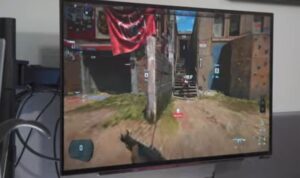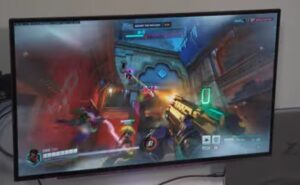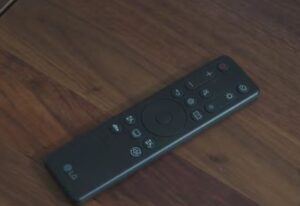Recently, LG launched 45-inch and 27-inch OLED monitors, and I’ve spent a good amount of time testing the 45-inch version. However, I was curious to see if there were any notable differences with the 27-inch model. Right away, it’s clear why many are choosing a 1440p OLED over some 4K monitors.
I mainly use my PlayStation 5 and PC for gaming, and both have performed exceptionally well, especially on this OLED panel. If you’re a tech and gaming enthusiast like me, this monitor might be exactly what you’ve been looking for. It boasts a 1440p resolution, up to a 240Hz refresh rate, and an impressive 0.03 millisecond response time, making it one of the top monitors available.
It’s important to note that this monitor doesn’t replace my LG C2 OLED in the living room. However, since the living room is often occupied by my two-year-old, having an OLED display in my own space is convenient. Today, I’ll walk you through my setup for both console and PC gaming, discussing all the pros and cons and the full feature set of this monitor.

Let’s start by talking about my setup and why I’ve chosen this monitor. To be honest, I’ve developed a strong preference for OLED panels, especially for gaming. From my perspective, they offer many benefits with only a few drawbacks.
I’ve grown to love the overall look of OLED displays. After gaming on the LG C2 OLED in my living room for the past year, which was my first experience with OLED, I’ve really gotten used to it. I also had the chance to use LG’s 45-inch OLED, which was an amazing experience.
Now, my setup features the 27-inch version of this monitor, which has the traditional 16:9 aspect ratio. It’s connected to my PlayStation 5, gaming PC, and work laptop. If you’ve seen my other videos, you might know that I’m a big fan of monitor arms. I’ll talk more about the stand that comes with this monitor later, but overall, I prefer using a monitor arm because it gives me more desk space and fits my aesthetic preferences.

It’s got a good selection that should meet most of your needs for both PC and console gaming. You’ll find two HDMI 2.1 ports, which allow you to connect multiple consoles or use one for a USB dock, like I do. There’s also a DisplayPort, perfect for PC gaming. Additionally, you’ll see two USB ports, which can come in handy. Just keep in mind that these USB ports only work with your PC when connected through the USB Upstream port and cable. Lastly, there’s an optical audio out port available as well.

In terms of looks, LG 27GR95QE OLED monitor is one of the most visually pleasing displays I’ve ever seen. Its build quality is outstanding, comparable even to my Apple Studio display. Thanks to its OLED panel, the screen is incredibly thin, maintaining a sleek profile despite a slight back hump. The build itself feels sturdy, with a metallic vibe, although it’s likely made of plastic.
Personally, I lean towards a more minimalist tech design, and this monitor fits the bill, lacking the flashy gamer aesthetic. Its back features an Ultra Gear emblem and textured hexagon backing, adding a bit of style. While I’m not big on RGB lighting, this monitor does have customizable hexa lighting on the back, which I usually set to a clean white or teal.
Overall, LG 27GR95QE OLED monitor impresses with its impeccable build quality and aesthetics, surpassing expectations in both regards.
Specs
- 240Hz Refresh Rate – Gear up for smooth gameplay with an ultra-fast 240Hz OLED display. The faster speed lets you respon…
- 0.03ms Response Time – Enjoy smoother scenes with less lag or ghosting thanks to LG UltraGear OLED’s nearly instantaneou…
- VESA DisplayHDR True Black 400 – VESA DisplayHDR True Black 400 certified means this monitor meets industry standards fo…

What I find most impressive about this monitor are its specifications. The standout feature is definitely the 240Hz OLED panel, delivering an incredibly smooth and responsive gaming experience. Additionally, the display boasts an astonishingly low response time of 0.03 milliseconds. So, if I’m frequently getting defeated in games, it’s likely due to my own lack of skill.
While this OLED display might not achieve the same brightness levels as an LED monitor, it still supports HDR and offers an impressive 98.3% color gamut coverage. Console gamers will be happy to know that the monitor supports VRR (Variable Refresh Rate) and is compatible with AMD FreeSync.
It’s worth noting that if you’re specifically seeking a 4K panel, this monitor doesn’t offer it. However, most users are quite content with the 1440p resolution it provides.
Console Gaming

When it comes to gaming on consoles, this monitor stands out as one of the top choices you should consider. Its stunning visual quality is a major factor, especially if you’re playing on a PlayStation 5 or any of the Xbox Series consoles. Whether you’re enjoying a classic or a new title, the difference is remarkable. The colors are vivid, and the blacks are deep and rich, making every game look exceptional on this monitor.
Equipped with HDMI 2.1 ports, you can take full advantage of a 120Hz variable refresh rate and the lightning-fast 0.03 millisecond response time. Games like Call of Duty offer an outstanding experience, with everything running incredibly smoothly, especially with the added support of AMD FreeSync. I’ve mentioned it before, but titles like Horizon Forbidden West and Cyberpunk 2077 look absolutely stunning in HDR. When you turn on HDR mode, the difference is truly striking. Personally, I’ve recently started playing Ghost of Tsushima, and I’m absolutely impressed by the image quality.
PC Gaming

But it’s not just console gaming; for me, gaming on PC is where I can truly satisfy my competitive craving, especially when playing games like Overwatch. That’s one of the few games where I become a true sweat lord. Currently, I hold the rank of Grand Master 3, and I’ve adjusted to playing at a 16:9 aspect ratio, coming from the 21:9 aspect ratio of the 45-inch OLED monitor. Personally, I find the 1440p resolution at 240Hz quite enjoyable since my RTX 2070 isn’t capable of achieving higher refresh rates at 4K. This monitor remains one of the few where I can actually dominate in this game.
On the topic of gaming, I must mention my all-time favorite game, Red Dead Redemption 2, which continues to be an absolute masterpiece, especially on a display like this. Certain moments in the game truly showcase the dynamic range that this monitor offers. Additionally, while playing Ghost of Tsushima recently, I’ve been getting similar immersive vibes. One thing I’ve noticed is that I prefer playing in the Vivid gaming profile compared to the FPS or other modes. This is mainly because the Vivid profile seems to increase the brightness even beyond the default maximum brightness setting, which brings me to all the other gaming-specific features of this monitor.
Gaming Features
There are several features in this monitor that can help improve your gaming experience and make you perform better. Let’s start with VRR, which stands for Variable Refresh Rate. It is incredibly useful because, during gaming, your frame rates can fluctuate depending on what you’re doing in the game. With VRR enabled, especially when using AMD FreeSync, the monitor synchronizes with your console or PC, adjusting to the actual frames being rendered by the GPU. This helps prevent screen tearing or blurring, resulting in smoother gameplay.
Furthermore, you have the option to adjust your black levels, which can be particularly beneficial when playing first-person shooters. Additionally, there are built-in crosshairs available. Initially, I thought crosshairs were just a gimmick, but after using them extensively in Call of Duty, I can definitely see their value. Year after year, Call of Duty weapons have intense recoil, and having the crosshair helps with accuracy. Additionally, there is an FPS counter included, although I personally don’t use it. If you prefer, you can display the current refresh rate by simply opening up the menu.
These features collectively contribute to an enhanced gaming experience, allowing for better control, precision, and visibility.
Other Features and Productivity

Besides gaming, this monitor offers a range of other tasks you can do. While I know gaming capabilities are your main focus, it’s good to know what else this monitor can do. Burn-in is a common concern with OLED displays, but this monitor has excellent pixel cleaning features to prevent it. You can adjust these settings to suit your preferences. In terms of professional work, you might expect higher brightness levels, but even in my office with a window, I haven’t had any issues with tasks like creative work or daily editing. While having a built-in Type-C port with power delivery for laptops would be ideal, you can always use a separate dock if needed.
For both gaming and productivity, this monitor has features to prevent burn-in. In addition to pixel cleaning, there are screen move features that slightly shift the display to prevent burn-in. Plus, there are different picture modes to suit various uses. I personally like the Vivid profile. As for RGB lighting, you can customize it in the menus or set it to cycle through colors. While it’s not the brightest option, it works well in darker environments. It’s important to note that this monitor doesn’t have a glossy option, which might enhance visuals but could cause glare issues with a window in the setup.
One thing to mention is that this monitor doesn’t have built-in speakers. You’ll need a headset for audio, which can be connected directly to your PC, console, or the built-in headphone jack at the bottom of the monitor.
Remote

I’d like to point out the remote that comes with the monitor because it’s your main tool for navigating menus. While there’s a small knob at the bottom, I suggest not bothering with it. The remote lets you easily adjust volume and brightness, switch inputs, and clean the OLED screen. Plus, there are buttons for quickly changing profiles or tweaking RGB lighting. Personally, I find this remote better than a traditional knob. Just be careful not to lose it, as it’s essential for effectively using the monitor.
Final Thought
So, that concludes my review of the 27-inch OLED monitor from LG. Overall, it’s an outstanding product, but it does come with a somewhat high price tag. I anticipate that LG might release a 4K version in the future, but for now, the 1440p resolution seems to be the sweet spot for the majority of gamers, whether they have newer or older hardware. I would love to hear your thoughts. Do you think it’s worth the $899 price tag? And if so, would you primarily be using it for gaming on a PC or console?
The 27-inch LG OLED monitor is an outstanding product, but its high price of $899 may not appeal to all gamers. The 1440p resolution is currently the preferred choice for gaming on PC or console.
-
Display9
-
Design9
-
Ports7.5
-
Performance8.5
-
Gaming8.5
-
Features9





